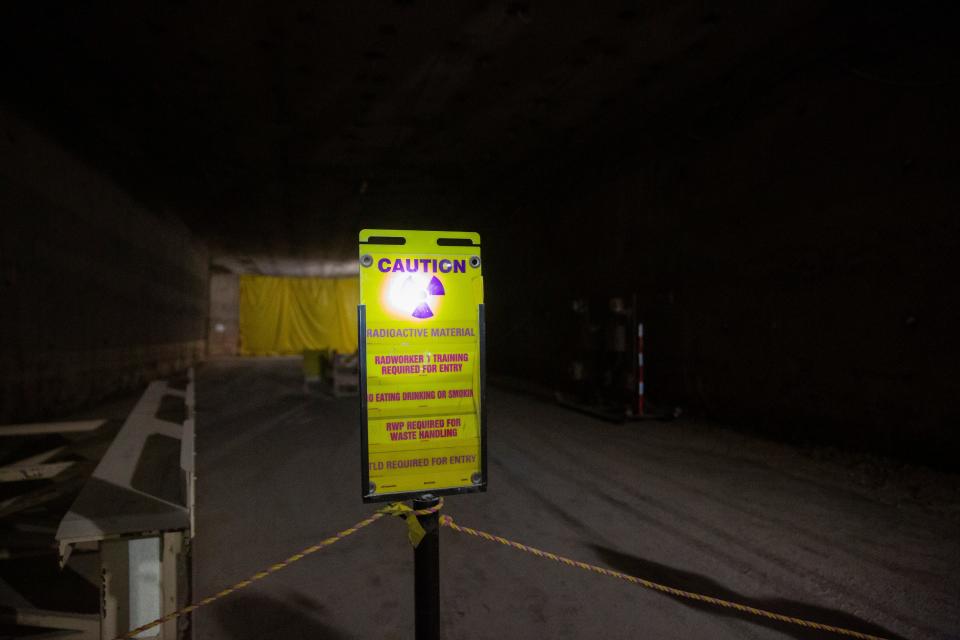More than 400 shipments of nuclear waste came to Carlsbad-area repository in 2023
About 400 shipments of nuclear waste from around the country were disposed of at a repository near Carlsbad this year, and federal officials said this exceeded their goal for 2023.
The Waste Isolation Pilot Plant, about 30 miles east of Carlsbad, takes in shipments of transuranic (TRU) nuclear waste from laboratories and facilities owned by the U.S. Department of Energy.
TRU waste is made up of clothing materials, equipment and other refuse irradiated during nuclear activities, and is shipped by truck to the WIPP site where it is buried permanently in a salt deposit about 2,000 feet underground.
More: Nuclear waste disposal permit issued for New Mexico site, WIPP to get bigger in November
This year, the DOE’s Carlsbad Field Office reported it reached its goal of 400 waste shipments in October, while it also avoided creating a backlog of waste from Los Alamos National Laboratory in northern New Mexico.
In-state shipments became controversial earlier this year as the New Mexico Environment Department (NMED) called for the facility to prioritize New Mexico waste.
That objective took the form of a clause in the DOE’s permit with NMED to operate WIPP for the next 10 years, requiring the federal agency to set aside space in the underground specifically for Los Alamos waste and to develop a plan to dispose of “legacy waste” leftover at the lab from the Cold War.
More: Final testing underway at $486M air system for nuclear waste site near Carlsbad
Carlsbad Field Office Manager Mark Bollinger said the shipment goal in 2023 was achieved “safely” from Los Alamos and other sites in the DOE’s complex.
“Exceeding 400 transuranic waste shipments to WIPP this year is a positive indication of the cleanup work we’re enabling throughout the nation,” he said. “WIPP’s mission to safely receive and dispose of waste shipments is instrumental to cleanup efforts at Los Alamos and other waste-generating sites, and we safely exceeded our goal at WIPP in 2023.”
But despite the push for more clean-up from within New Mexico, records show WIPP mostly took in waste from other states.
More: A nuclear reactor in Carlsbad? City officials call for project at federal waste repository

WIPP received 423 shipments in 2023, as of Thursday according to the latest DOE data, with 334 or 78 percent coming from Idaho National Laboratory.
Los Alamos sent 49 shipments to WIPP during that same time frame, records show, about 11 percent of the total.
Other major shippers this year were the Savannah River Site in South Carolina with 24 shipments as of Thursday, the DOE reported, and Oak Ridge National Laboratory in Tennessee with 18 shipments.
More: Oil & gas industry joins fight against nuclear waste site proposed in southeast New Mexico
Since opening in 1999, more than half of the waste disposed of at WIPP came from Idaho – 7,118 or about 52 percent of the total 13,749 shipments to the facility as of Dec. 2.
And the DOE said it planned to ramp up shipments to an average of 17 per week in the coming months, a rate that would equal about 884 shipments if maintained every week of the year.
Tammy Hobbes, WIPP operations and TRU program manager with Salado Isolation Mining Contractors (SIMCO) – the DOE-hired contractor to oversee daily operations, touted the workforce that prepared waste for shipments while maintaining, she said, the safety of the facility.
More: Feds tout progress in cleaning up nuclear waste at Los Alamos using Carlsbad-area site
“I’m especially proud of everyone embodying the core values of safety, quality and productivity as we characterized, packed, shipped, received and emplaced each waste container this year,” Hobbes said.
The safety of WIPP’s operations was called into question by government watchdogs and state lawmakers this year.
This surrounded the DOE’s plans to increase the production of plutonium pits at both Los Alamos and Savannah River, a project that left some worried new weapons-based waste could come to WIPP despite its initial mission of cleaning up legacy waste.
More: Air shaft at nuke repository near Carlsbad hits final depth amid recent safety incidents
And the DOE recently announced plans to “downblend” or dilute surplus weapons-grade plutonium to meet WIPP’s acceptance standards before being shipped to WIPP.
These efforts not only increased risks at the WIPP site, but also along its transportation routes, said Joni Arends with Concerned Citizens for Nuclear safety during a public forum held in Carlsbad.
"It seems to me that while LANL waste needs to be prioritized, it should not be nuclear weapons waste,” she said before WIPP officials.
Kenneth Princen, assistant manager of the DOE’s Carlsbad Field Office, said in response that as soon as LANL’s legacy waste is ready to go to WIPP, it is shipped and disposed of.
“We’re maintaining a posture where as soon as they have it characterized, we’re going in there, certifying it and shipping it to WIPP,” he said.
Adrian Hedden can be reached at 575-628-5516, achedden@currentargus.com or @AdrianHedden on X, formerly known as Twitter.
This article originally appeared on Carlsbad Current-Argus: More than 400 shipments of nuke waste came to Carlsbad-area repository

